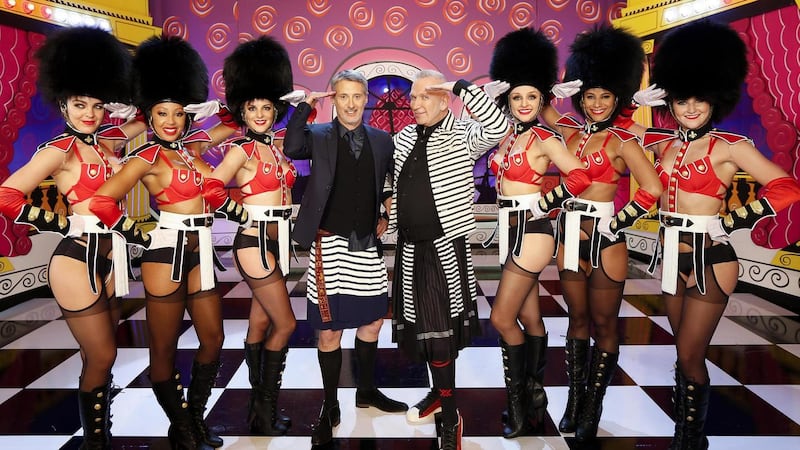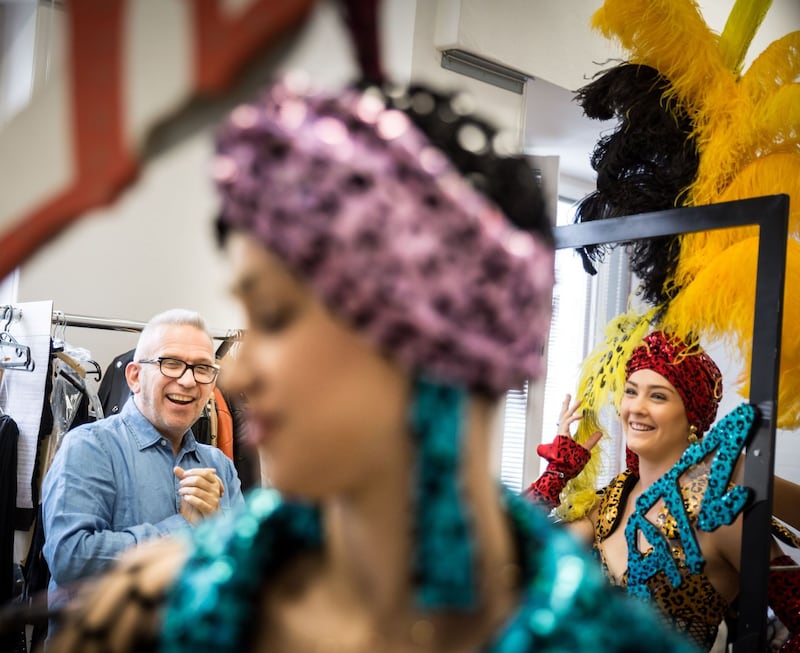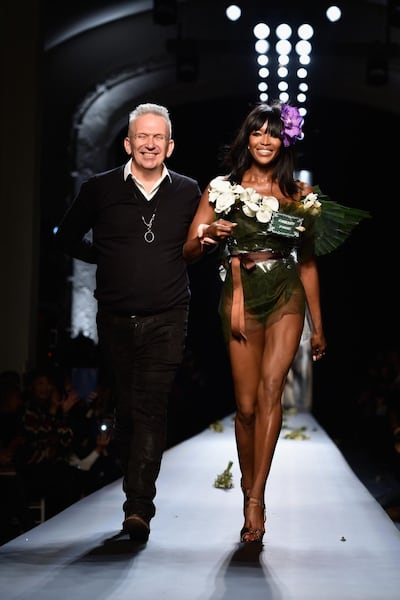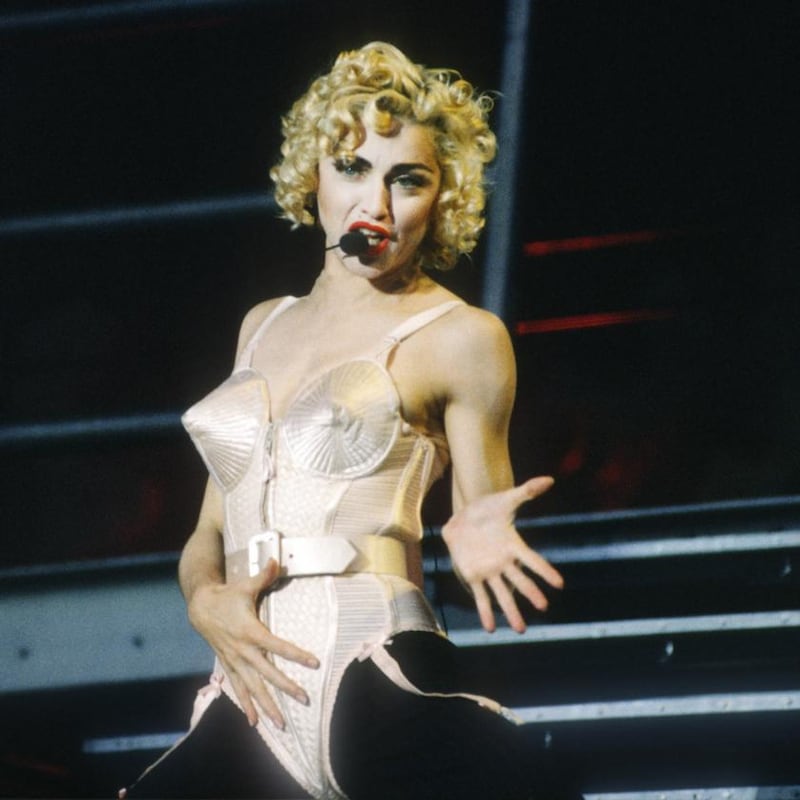Jean Paul Gaultier is waving his hands and talking nineteen to the dozen in French with a smattering of heavily accented English. I've only been with him for a few minutes, and already he is tearing through his thoughts on love, life and death, punctuated with self-deprecating comments and shrieks of laughter, as if we have known each other for ever.
We are supposed to be talking couture; he is, after all, fashion's anointed "enfant terrible", the designer celebrated for dressing Madonna in a conical bra corset, popularising skirts – well, kilts – for boys and turning the French navy's famous marinière striped T-shirt into a wardrobe classic.
We are sitting in his atelier in what is now known as the Haut Marais, a stone’s throw from Paris’s once disreputable but now increasingly gentrified Saint-Denis district. It is an elegant belle-epoque building commissioned in 1912 by the Avenir du Prolétariat (Future of the Proletariat) society. Outside, the tall, arched windows are topped with carved faces designed to see off evil spirits. Gaultier, who has been here for 17 years, redecorated the entrance hall with striking silver metro tiles, and the enormous galleried ballroom is used for his runway shows. In previous incarnations, the building was a ribbon factory, a boxing hall, a nightclub and a presidential-campaign headquarters.

I’ve been told that Gaultier, who officially retired after his 50th-anniversary haute couture show in January 2020, wants to talk about what he later calls his forthcoming “adventures” in cinematic fashion and television. Instead, the interview zigzags through a swath of subjects faster than a pattern-cutter’s shears.
Fashion aside, many people will remember Gaultier for Eurotrash, the cult late-night Channel 4 series he cohosted in the 1990s with another Frenchman, Antoine de Caunes: 30 minutes of weird news stories, innuendo and what De Caunes described as “the best of bad taste”. At one point it was Channel 4’s most popular show. The pair are still friends: Eurotrash was revived for a Brexit special in 2016, and when Gaultier staged his autobiographical revue Fashion Freak Show at the Folies Bergère – due to be reprised at some point – De Caunes had a cameo as a beer-drinking queen.
I suggest that the smutty silliness of Eurotrash would probably not get past TV commissioners these days. Gaultier looks incredulous. “Not even in England? Has it really become no-sex-please-we-are-British? I don’t believe it,” he says. “But we probably couldn’t do it now because everything gets criticised by the haters so quickly on social media. It’s terrible, terrible, terrible. It’s a shame to have to think about what you can and cannot say, especially if you are spontaneous like me and have a tendency to say stupid things. Ha ha ha ha.”
Gaultier says he loves speaking English. He could not care less if, as De Caunes once said, his grasp of the language “is really crap”.
Looking back, I don't think I'd like myself as a child at all, because I was really a small adult. I was an only son who was spoiled rotten by my grandmother and my parents
“I realise I have an accent and I don’t speak well at all, but my desire to express myself is stronger than the idea it has to be perfect,” Gaultier says. “In French we have a saying that ‘le ridicule tue’ – ridicule kills – but I don’t give a damn about being ‘ridiculous’, and that’s why I like English humour so much. You rise above it.”
Gaultier is the perfect interview subject if you have limitless time and not, as in this case, one hour. His brain is as hyperactive as his hands, producing answers that whirl off in unexpected directions until he stops to ask: “What was the question again?” Today, the trademark spike-top hair is more grey than bleached blond, but Gaultier appears to have reached the age of 68 without growing up or losing a sense of childlike wonder at living his “childhood dream”. He is particularly excited to “announce” he is joining the jury of the French version of Strictly Come Dancing, and is deflated when I say I already read that somewhere.
“Oh you know. It’s supposed to be a secret,” he says, looking crestfallen for a fraction of a second before another burst of laughter. “Of course, this wasn’t a childhood dream, but it reminds me of my father who taught me to dance. I love The Voice, too, but thankfully nobody asks me to sing, even if I once made a record [he means the 1988 dance single How to Do That], and it only sold 30,000 copies. I was happy with the publicity, but in truth it wasn’t great. I don’t have a voice. Ha ha ha ha.”
Gaultier, who struggled at school and was painfully shy, grew up on a council estate in the Paris banlieue, the only child of an accountant father and a mother who worked as a cashier in an office canteen. He says he was an awkward child, who did not feel “comfortable in my skin”.

“Looking back, I don’t think I’d like myself as a child at all, because I was really a small adult. I was an only son who was spoiled rotten by my grandmother and my parents. I was an outcast at school because I wasn’t a fighter, I didn’t play football, and I had a dispensation to miss gymnastics; sometimes I was called a fille manquée” – a tomgirl – “although I wasn’t effeminate.”
A black-and-white family photograph shows a young Gaultier hugging his adoring grandmother Marie Garage, a nurse, beautician and purveyor of alternative medical treatments. It was Garage’s cache of corsetry, which the young Jean Paul discovered while rifling through her belongings when she was with clients, that inspired him to make a conical paper bra for his teddy bear.
“I wanted a doll, not a bear, but I did its hair and used my grandmother’s make-up on it. And I made a conical bra for it: it was the first conical bra, even before Madonna’s. I grew up on television, not books, and I’d also seen this programme that showed you could cut a circle out of a circle to make a skirt, so I made a hole in one of my grandmother’s lace mats and turned it into a skirt for the bear.”

Gaultier says he realised he was gay as a teenager after seeing Franco Zeffirelli’s 1968 film Romeo and Juliet and dreaming of Olivia Hussey and Leonard Whiting, before deciding he was more attracted to Whiting. He came out to his parents when he was in his early 20s. “I was lucky because they were very open and free-thinking. We didn’t talk about it before, but I think they knew. My father didn’t care and didn’t say anything. My mother said: ‘Ah, now we understand why you are so often in London,’ which was much better [for gay men] than Paris back then. All this ‘no sex please, we’re British’ is completely fake. Au contraire!” Cue more raucous laughter.
It was another film, Jacques Becker’s 1945 classic Falbalas, in which Micheline Presle falls in love with a fashion designer, that inspired him to become a couturier. A large black-and-white photograph of Presle, who is now 98, hangs on the wall outside Gaultier’s atelier. “I saw Falbalas, and said, ‘I want to do that,’” he says. Gaultier had already been drawing for some time and had sent his sketches to several Paris fashion houses. On his 18th birthday, Pierre Cardin’s atelier called the Gaultier home, asking Jean Paul to come in immediately for an interview. He was employed on the spot, part-time at first, so he could finish school. “I knew Jean Paul had talent the day he arrived,” Cardin would say later.
"I owe him everything," Gaultier said after Cardin's death last December. "I dreamed of working in fashion, and Pierre Cardin made that dream possible." After his grandmother and Cardin, perhaps the greatest influence of Gaultier's life was Francis Menuge, his personal and professional partner. Gaultier was 22 when he met Menuge, then 20, through a school friend. It was, he says, a coup de foudre – love at first sight. "He saw my work, and he helped me and supported me. I already knew I would have a career in fashion, and I knew that one day I would do a collection, but I thought it would probably be for one of the big houses. Instead, we did our own pret-a-porter collection," he says.
The collection was thrown together on a shoestring in 1976, with the help of Menuge, family members, including cousins who knitted sweaters, and even the local concierge, who did some sewing. The show at the Paris Planetarium was chaotic, featured nine models who were friends and was attended by a similar number of journalists, but caught the fashion world’s attention. “We were only able to do it because of Francis. I was shy, I didn’t dare do lots of things, but he would say: ‘Why not? Go on, just do it.’ He was also extremely direct and would tell me when he thought a piece of clothing or a collection was just rubbish.”
In 1987, Menuge was diagnosed as being HIV positive. He died three years later, by which time the couple had been together for 15 years. Gaultier was bereft and briefly considered giving up designing. “It was terrible, and at that time a total taboo. You didn’t say Aids, you said ‘la maladie’, but even then you said it discreetly, because everyone knew what ‘la maladie’ was, and everyone died from it. It was a terrifying period. Francis died three months before they discovered the drugs to extend the life of those with Aids. I didn’t want him to die in hospital, so I brought him home and he died there.
“Afterwards, I said to myself: ‘Okay, I can stop now. I don’t want to be a celebrity, and this is bigger than my career.’ But that thought lasted about three seconds before I said to myself: ‘No, we continue, because we, Francis Menuge and Jean Paul Gaultier, have done something special together.’ In any case, I couldn’t do anything else.” Later, Gaultier apparently told a French journalist: “My only regret is not having invented the condom, the most beautiful item of clothing.” Yes, I said that, he says. “And it’s true.”
It was around this time Gaultier created one of his truly iconic outfits: the pink conical bra corset that was one of a series of designs for Madonna’s 1990 Blond Ambition tour. When Madonna first called him in 1989, he thought his assistant was playing a prank on him. “I’d seen her singing Holiday on Top of the Pops and thought she was absolutely my style – the jewellery, the crucifixes, the way she dressed, her look – this was what I was doing with my collection. I adored her.”

He has also worked with Carla Bruni, the former model who became France’s first lady, Eva Herzigová, Nicole Kidman and Beyoncé, and says he is very fond of Naomi Campbell. “She has an exceptional grace and beauty. Even if she does always arrive very late, she is really someone special.”
Gaultier presented his first haute-couture collection to acclaim in 1997. He says he did it “for pleasure, not for the establishment”. He worked for himself – as opposed to one of the major fashion houses – because it gave him freedom. And today, what he wants is not to be a slave to producing collections but to commission young designers to “reinterpret” Jean Paul Gaultier. The day before we meet, the Japanese creator Chitose Abe has presented a “reinterpreted” collection. Gaultier is delighted with it, and thanks staff for their hard work as he walks around the atelier.
For now, Gaultier says he will be sticking to fashion-adjacent projects; one of these is CinéMode, which will run from October to January at the Cinematèque in Paris, and is an exhibition of 100 film costumes that have left their mark on fashion, from those of Marlene Dietrich to James Bond via Superman. Gaultier has always loved big films and has designed for the directors Pedro Almodóvar and Luc Besson.
Yes, I am happy. I realised my childhood dream and I continue to do so. What is my work is also my amusement, and I am amused all the time
He insists he will not miss the punishing rhythm of producing several couture collections a year. “Fashion has changed. Before, if a star wanted a piece of clothing they had to buy it, and that’s normal, non? Then it became a loan, then we will give it to you, then we will give you the entire wardrobe. Now, it’s: not only will we give you the entire wardrobe, but we will pay you a contract to wear it. And not even an exclusive contract.
“I was happy when people like Boy George and George Michael were wearing my clothes, and when Mick Jagger asked me to do his show … that was real work. But today couture is all about contracts and money.”
We could go on and on, but Gaultier has a lunch appointment followed by a flight to Spain, where he is holidaying. It is time to go. It has been huge fun. As a last question, I ask if he is happy. “Yes, I am happy. I realised my childhood dream and I continue to do so. What is my work is also my amusement, and I am amused all the time.” He laughs one last laugh. “I didn’t do this as a career to be rich or famous. I wanted to work. And I wanted to be loved. At the end of the day, perhaps it is this kind of honesty that made me the enfant terrible of fashion.” – Guardian


















